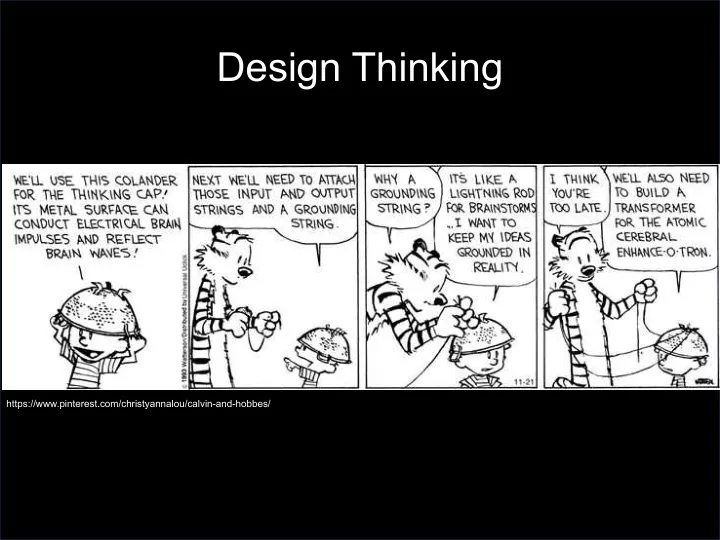

Design Thinking https://www.pinterest.com/christyannalou/calvin-and-hobbes/
MAC0446/MAC5786 Introdução à IHC Design Thinking Prof. Carlos Hitoshi Morimoto Computer Science Department IME/USP
Leituras recomendadas ● User Experience and Experience Design BY MARC HASSENZAHL − https://www.interaction-design.org/literature/book/the- encyclopedia-of-human-computer-interaction-2nd-ed/user- experience-and-experience-design ● 5 Stages in the Design Thinking Process BY RIKKE DAM AND TEO SIANG − https://www.interaction-design.org/literature/article/5-stages- in-the-design-thinking-process − Veja também o webinar do Bill Burnet https://www.youtube.com/watch?v=iPEsVB8G4xQ
Aulas anteriores • HCI • Usabilidade x Experiência do Usuário • Design • O que é Necessidades e Requisitos • Importância de um bom design • Como chegar a um bom design • human centred design DCU ideias Avaliação • Avaliação • Coleta de dados Prototipos
Design Thinking
A 5 State Process
parece fácil, certo?
Parece fácil • pois • Basta conversar com o usuário • Construir o que ele pede • e pronto!
.. mas não é! • Usuários não sabem o que quer ou o que pode ser feito • Se eu tivesse perguntado às pessoas elas teriam dito que “precisamos de cavalos mais rápidos” • frase atribuída a Henry Ford • É necessário descobrir o que do que o usuário necessita • Ao descobrir que algo pode ser feito, usuário tendem a mudar de ideia • “wicket problem" • Design thinking é a técnica que vamos utilizar para desenvolver produtos inovadores.
Etapas da técnica de Design Thinking
1. Empathise – research your user's needs - Gain empathetic understanding of the problem - Typically through user research - Empathy is crucial to a human centered design process - allow you to set aside your own assumptions - gain real insight into users and their needs To know more: watch “Need-finding and empathy: why your customer can't tell you what they want”, by William Burnet. https://www.youtube.com/watch?v=iPEsVB8G4xQ
2. Define – state your user's needs and problems ● Accumulate the information you collected during the Empathize stage. ● Analyze and synthesize them to define the core problems ● Seek to define the problem statement in a human centered manner
3. Ideate – challenge assumptions and create ideas ● Think outside the box ● Divergent thinking – generate lots of ideas ● Look for alternative ways to view the problem ● Identify innovative solutions to the problem statement you created
4. Prototype – start to create solutions ● Experimental phase ● Try to identify the best possible solution for each of the problems ● Produce a number of inexpensive, scaled-down versions of the product
5. Test – try your solutions out ● Rigorously test the complete product using the best solutions ● Can be the final phase ● Or iterate − Redefine one or more further problems − Return to previous stages and refine − Rule out alternative solutions
Summary ● Design Thinking process is iterative, flexible and focused on collaboration between designers and users, with an emphasis on bringing ideas to life based on how real users think, feel and behave. ● Design Thinking tackles complex problems by: 1.Empathising: Understanding the human needs involved. 2.Defining: Re-framing and defining the problem in human- centric ways. 3.Ideating: Creating many ideas in ideation sessions. 4.Prototyping: Adopting a hands-on approach in prototyping. 5.Testing: Developing a prototype/solution to the problem.
Recommend
More recommend